Sports Tech@TDK
Making the World Cup More and More Exciting with the VAR System and Football Sensor Technology - Offsides determined by VAR-

Soccer* is a popular sport with an extremely large number of players and spectators worldwide. The FIFA (Fédération Internationale de Football Association) World Cup, held every four years, is a championship tournament in which 32 teams from all over the world (48 teams starting 2026) come together to compete for the title of best soccer team in the world. For nearly a month, the entire world meets in this melting pot of excitement as the heated competition of the league groups and the final tournament unfolds. In recent years, the DX (Digital Transformation) wave has started hitting the sports world as well. In addition to the VAR system in football for video judgment of fouls and other things, semi-automatic offside technology was introduced with the 2022 World Cup in Qatar.
*American term for : Football
VAR System Decides Japan-Spain Game in 2022 FIFA World Cup -Offside VAR-
The strength of the football VAR system was demonstrated to a global audience at the 2022 World Cup in Qatar with a game between Japan and Spain. VAR is short for video assistant referee, a system that uses video images from 12 tracking cameras near the roof of the stadium and numerous high speed VAR cameras around the field for instant replays of the play. In the Japan-Spain game, Kaoru Mitoma of Japan shot the ball just short of the goal line, and Ao Tanaka pushed it home to give Japan an important 2-1 victory over Spain, a football powerhouse, and advance to the finals of the tournament. The ball shot by Mitoma seemed to have crossed the goal line visually. However, the VAR technology system showed that the ball was just 1 mm inside the line, and the referee confirmed that it counted as a goal.
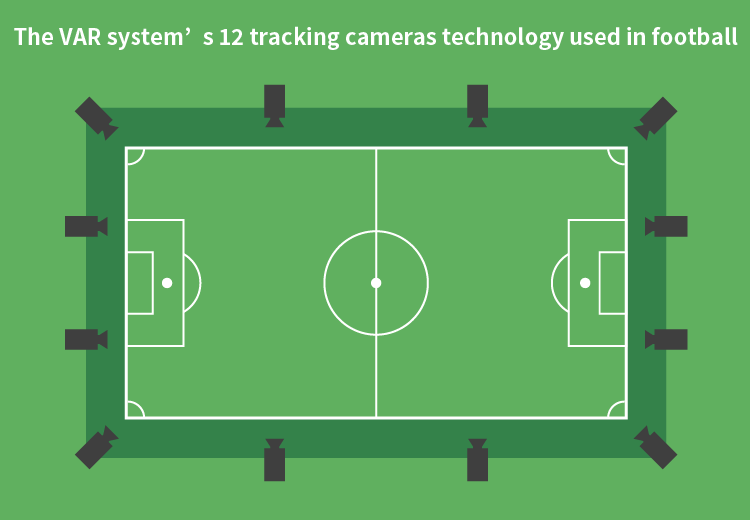
These video referee cameras track the position of the ball and the players 50 times per second. In addition, a number of other cameras, including high speed cameras, are positioned around the field.
Offside Decision by Ball With Built-in Smart Football Sensor
Meaning of VAR:the VAR system was introduced in the 2018 World Cup in Russia, and semi-automatic offside football technology was added to support the Video Assistant Referee System system starting with the 2022 World Cup in Qatar. Offside is a rule that states the attacking team must have at least two players of the defending team, including the keeper, between the defense team's goal and the player receiving the pass. The assistant referee must constantly check the offside line, which is the line of attack and defense, and the place the ball is being passed, making it extremely difficult to judge. As a solution to this problem, semi-automatic offside technology was introduced. This system incorporates a small IMU (Inertial Measurement Unit) in the center of the ball and works in conjunction with the football VAR tracking cameras to determine offsides.
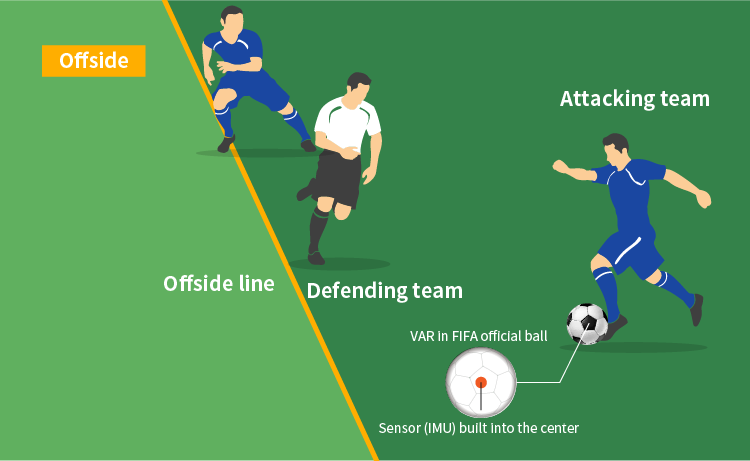
Semi-automatic offside technology
The positional information of the ball and the player is detected by the tracking camera, and the moment the ball is kicked it gets detected by the IMU, and converted into a 3D animation to determine if the player is offsides.
An IMU is a type of inertial sensor that combines an accelerometer and a gyroscope (angular velocity sensor) to detect motion, vibration, and shock. IMU (made by InvenSense), manufactured using advanced MEMS (micro-electro-mechanical systems) technology, was used as the official ball for the 2022 World Cup in Qatar. Here is a brief explanation of the principle of inertia. According to the law of inertia, when an external force is applied to a stationary object or an object in a linear constant velocity motion, inertial force acts to maintain its original motion. In other words, when a car suddenly starts moving forward or stops, you feel your body being pushed back or forward because of the inertial force acting on it. Further, when an object in motion is subjected to rotation, inertial force acts to maintain its original path. This is called the "Coriolis force," and its magnitude is proportional to the angular velocity (rotational speed) of the rotation. The FIFA official ball detects acceleration and angular velocity 500 times per second and sends the data to the VAR room, where it is linked to video data to make offside decisions. This is a "semi-automatic" system, as the final decision is made by the referee, but this technology is said to have virtually eliminated visual misjudgments like in the past. IMUs are expected to be used in basketballs and rugby balls in the future, and sensor and sensing technology will greatly expand the enjoyment of watching sports.
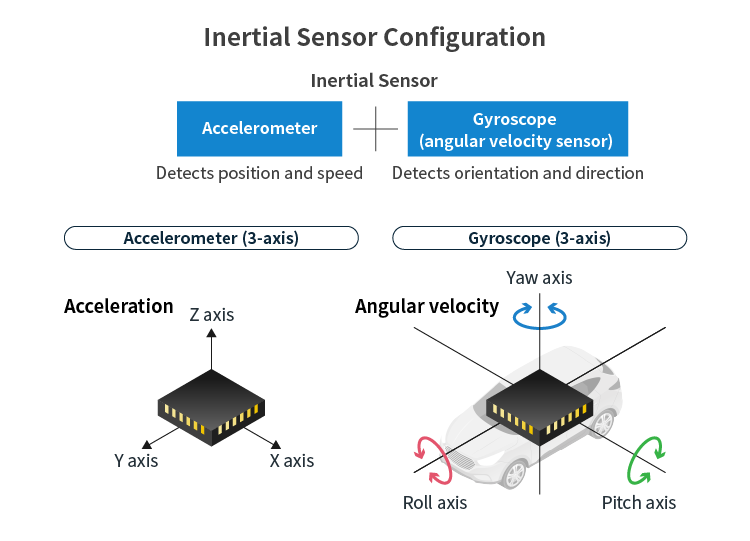
Principle and Structure of MEMS Accelerometer and MEMS Gyroscope
Here is the principle of accelerometers and gyroscope based on the advanced MEMS process. MEMS is short for micro-electro-mechanical systems, a technology that integrates moving parts such as sensors and actuators as well as circuits on a silicon substrate (a wafer) by applying microfabrication technology used in semiconductor manufacturing. Both MEMS accelerometers and MEMS gyroscopes have a structure in which a transducer is formed supported by springs on a silicon substrate. Around the resonator, comb-shaped movable electrodes are offset across comb-shaped fixed electrodes. Both of these interact to create a detection method called the capacitance method, which is based on the same principles used in that of a condenser microphone. As shown in the figure below, when acceleration is applied to the MEMS accelerometer, the resonator is displaced in the direction of acceleration due to inertial force, and the distance between the movable and fixed electrodes changes, causing the capacitance to change, which is detected to measure the magnitude of acceleration.
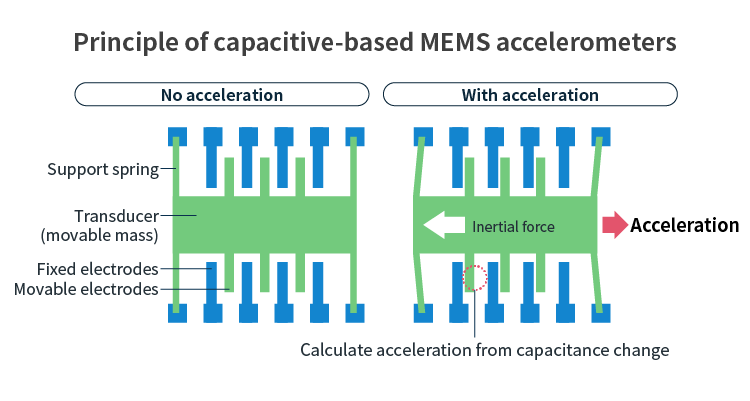
In MEMS gyroscopes, the transducer is kept in constant vibration. When rotation is applied to the sensor, Coriolis force acts perpendicularly to the direction of vibration of the vibrating body, changing the distance between the movable and fixed electrodes, and the magnitude of angular velocity is measured from the change in capacitance.
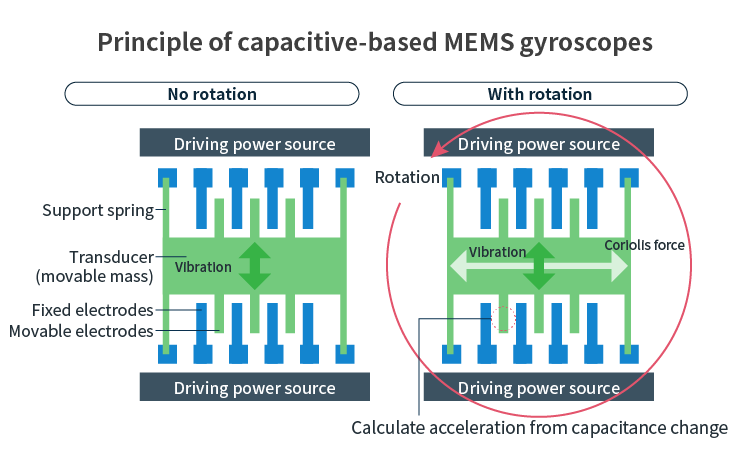
Since MEMS sensors incorporate tiny, delicate moving parts, dust and other debris from the dicing (cutting) of the wafer getting into chips can clog the moving parts and cause malfunctions. Therefore, a technology called WLP (Wafer-level packaging) has been introduced to protect moving parts by packaging them at the wafer stage before they are made into chips. There are various methods for the WLP process, but TDK's inertial sensors use a proprietary process called the Nasiri process of InvenSense, a TDK Group company. This is a revolutionary method that eliminates the wire bonding process by encapsulating a CMOS wafer with signal processing circuitry and a MEMS wafer with sensor components, electrically bonding them together and covering them with a lid.
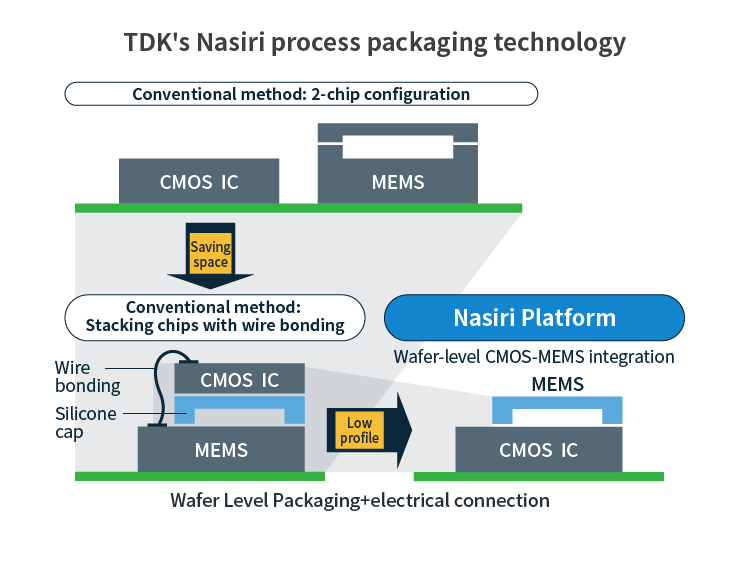
It is said that packaging and testing accounts for more than half of the manufacturing cost of MEMS sensors. The Nasiri process is an innovative technology that significantly reduces the time and cost involved in design, prototyping, packaging, and testing, which have traditionally been the bottlenecks in MEMS sensor development. TDK inertial sensors are not just sensors in football they also used in a variety of fields, including smartphones, drones, robots, and automobiles.
TDK IMU (Inertial Measurement Unit) Product Examples

A compact, high-performance inertial measurement unit integrating a MEMS accelerometer and a MEMS gyroscope. We offer a diverse lineup of products, including a 6-axis IMU consisting of a 3-axis accelerometer and a 3-axis gyroscope, a 7-axis IMU combined with a barometric sensor, and a 9-axis IMU combined with a 3-axis magnetic sensor (electronic compass).
TDK is a comprehensive electronic components manufacturer leading the world in magnetic technology







